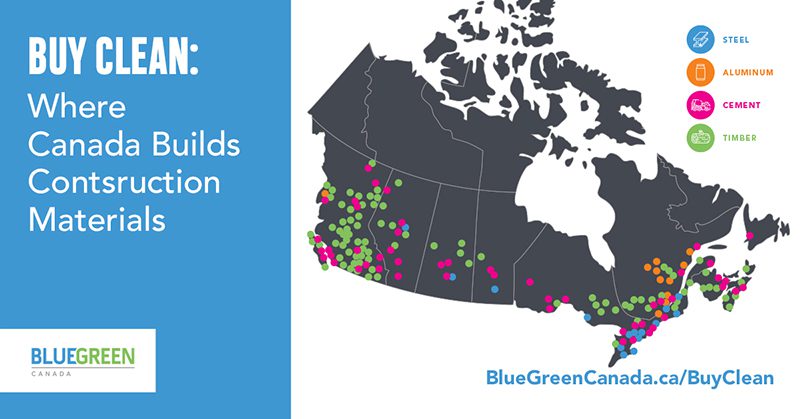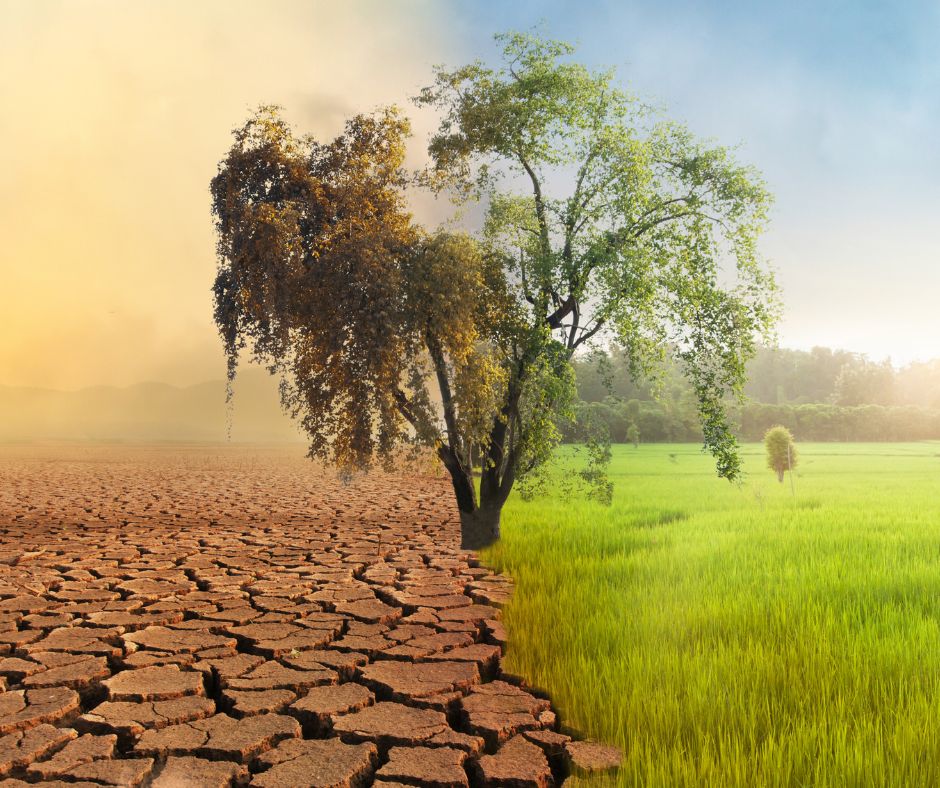This post is by Jamie Kirkpatrick, Program Manager, Blue Green Canada. Blue Green Canada released its new report– BUY CLEAN: How Public Construction Dollars Can Create Jobs and Cut Pollution– calling on Canadian governments to shift their infrastructure spending to lower carbon options to support Canadian industries and workers. An op-ed on this report was published in the Hill Times this week.
Every time we build something – like buildings, roads, airports, wastewater systems – we create carbon emissions. Buildings alone account for 13% of greenhouse gas emissions in Canada. And since we expect these projects to last, how we build and what we build with is incredibly important for both our environment and our industries.
However, that’s not a reason to throw up our hands – it’s actually a huge opportunity to invest in greening our economy. We can clean up our carbon AND support Canadian manufacturing by starting with how we look at public infrastructure.

How building bridges can drive climate action
The term “public infrastructure” encompasses a wide variety of things we use every day: like roads, light rail systems, bridges, hospitals, community centres, and more. And when governments fund and build these things, they can make climate change a key part of their decision-making by rewarding climate leaders and supporting the low carbon transition of Canada’s industries and economy.
The Government of Canada’s target of achieving net-zero emissions by 2050 will require substantial carbon reductions across all parts of the economy. This means that, to meet that goal, we’ll increasingly have to find ways to build infrastructure in a way that reduces pollution.
The good news is there is a solution and there are already some pieces in place.
| THE CITY OF VANCOUVER: FIRST IN CANADA
In Canada, the City of Vancouver is taking the lead on addressing embodied emissions in construction. In May 2017, the City introduced a new green buildings policy with a compliance path that requires the reporting of embodied emissions using a whole-building Life Cycle Assessment (LCA) perspective for projects seeking rezoning. The City is now aiming to reduce embodied carbon of new construction projects by at least 40% by 2030. |
In 2016, the federal government set up the Investing in Canada Plan, which proposes to spend a historic $180 billion over its 12-year lifespan to improve public transit, green and social infrastructure, trade and transportation, and rural and remote communities.
And yet, projects supported under the Investing in Canada Plan to-date have not prioritized lower-carbon materials and construction processes. This is a missed opportunity.
When governments prioritize spending their budgets on environmentally sustainable, low carbon construction materials, they’re participating in a growing movement called Buy Clean— and it should be a crucial component in our economic recovery.


What is Buy Clean?
Buy Clean means that governments’ attach requirements on infrastructure spending so that public construction projects use cleaner, more resilient, and lower carbon materials. When we Buy Clean, our tax dollars will help us fight climate change by ensuring we aren’t building public infrastructure in a way that makes the crisis worse.
Buying Clean makes sense for Canada. First, it makes use of our carbon advantage. Materials sourced from within Canada are usually lower carbon than imported materials. Canada’s energy and electricity systems are amongst the cleanest in the world and our manufacturers are highly efficient. In fact, Canada’s electricity grid is over 80% carbon emission free! So when materials are made here using Canadian energy and ingenuity, less carbon pollution is emitted than if they were produced in most international markets.
Second, it requires less transportation. When materials produced in Canada are used, emissions associated with transportation are reduced by avoiding shipping from international suppliers. Currently, Canada spends more than $7 billion annually on imported steel and aluminum; materials that are typically higher in carbon than domestic options.
Finally, Buying Clean also supports local economies. Low-carbon, clean building materials are often produced domestically, which means support for Canadian manufacturing and workers.
| CALIFORNIA: A LEADER IN CLEAN INFRASTRUCTURE
In 2016, the BlueGreen Alliance and its partners initiated the Buy Clean California campaign to support the advancement of policies that make sure California’s procurement processes for infrastructure support California’s goals to reduce climate change pollution. In 2017, the Buy Clean California Act was introduced, and is the world’s first legislative effort to address imported carbon emissions. The Act requires state agencies to weigh the carbon cost of materials used in infrastructure projects, including steel, glass, and certain kinds of insulation. Only products with Environmental Product Declarations (EPDs) demonstrating lower carbon pollution than a benchmark set for each product category are eligible for use in state projects. The Buy Clean California Act is not perfect. Currently, it covers just four construction materials: concrete-steel rebar, flat glass, structural steel, and mineral-wool board insulation. It does not cover wood, concrete, cement or aluminum– all of which are used in abundance in infrastructure. But the Golden State is paving the way for others to start addressing embodied carbon in their own construction projects and building on its pioneering approach. |
To take advantage of Canada’s domestic carbon advantage and support products and materials that help to cut pollution, the following three actions are recommended:
- Use government procurement to support Buy Clean policies— so that public infrastructure dollars prioritize lower carbon materials, fuels, and processes, thereby creating new markets, supporting jobs, and stimulating demand for these products.
- Develop a strategy to help industries decarbonization— including construction material manufacturing. This strategy should help identify the carbon advantage of Canadian industries and manufacturers, to demonstrate, commercialize, and promote high-potential technologies to further reduce the carbon footprint of Canadian manufacturers, and to help Canadian products become the lowest carbon products in the world.
- Establish a Clean Infrastructure Challenge Fund— to encourage the use of low carbon building materials in the construction of public infrastructure, and showcase their potential for inclusion in all forms of public infrastructure.
Blue Green Canada looks forward to engaging with governments and representatives across the country to promote the implementation of these achievable actions designed to capitalize on Canada’s domestic carbon advantage and support Canadian workers.
The report is available for download in English or French:
- BUY CLEAN: How Public Construction Dollars Can Create Jobs and Cut Pollution
- ACHETER PROPRE: Créer des emplois et réduire la pollution par une utilisation judicieuse des fonds publics en construction
Blue Green Canada was founded by an alliance between Canadian labour unions and environmental and civil society organizations, to advocate for working people and the environment by promoting solutions to environmental issues that have positive employment and economic impacts.







